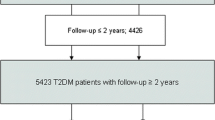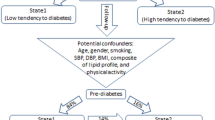Abstract
Structured models are population models in which the individuals are characterized with respect to the value of some variable of interest, called the structure variable. In the present paper, we propose a glycemia-structured population model, based on a linear partial differential equation with variable coefficients. The model is characterized by three rate functions: a new-adult population glycemic profile, a glycemia-dependent mortality rate and a glycemia-dependent average worsening rate. First, we formally analyze some properties of the solution, the transient behavior and the equilibrium distribution. Then, we identify the key parameters and functions of the model from real-life data and we hypothesize some plausible modifications of the rate functions to obtain a more beneficial steady-state behavior. The interest of the model is that, while it summarizes the evolution of diabetes in the population in a completely different way with respect to previously published Monte Carlo aggregations of individual-based models, it does appear to offer a good approximation of observed reality and of the features expected in the clinical setting. The model can offer insights in pharmaceutical research and be used to assess possible public health intervention strategies.










Similar content being viewed by others
References
Adimy M, Crauste F, El Abdllaoui A (2008) Discrete-maturity structured model of cell differentiation with applications to acute myelogenous leukemia. J Biol Syst 16(03):395–424
Aiello WG, Freedman HI (1990) A time-delay model of single-species growth with stage structure. Math Biosci 101(2):139–153
Arino O (1995) A survey of structured cell population dynamics. Acta Biotheor 43(1–2):3–25
Bell GI, Anderson EC (1967) Cell growth and division: I. A mathematical model with applications to cell volume distributions in mammalian suspension cultures. Biophys J 7(4):329–351
Centers for Disease Control and Prevention (CDC)-National Center for Health Statistics (NCHS) (2015) National health and nutrition examination survey data (NHANES). http://www.cdc.gov/nchs/nhanes.htm
Centers for Disease Control and Prevention (CDC)-National Center for Health Statistics (NCHS) (2015) Wide-ranging online data for epidemiologic research (WONDER). http://wonder.cdc.gov
Chu J, Ducrot A, Magal P, Ruan S (2009) Hopf bifurcation in a size-structured population dynamic model with random growth. J Differ Equ 247(3):956–1000
De Gaetano A, Hardy T, Beck B, Abu-Raddad E, Palumbo P, Bue-Valleskey J, Pørksen N (2008) Mathematical models of diabetes progression. Am J Physiol Endocrinol Metab 295(6):E1462–E1479
Evans LC (1998) Partial differential equations. Graduate studies in mathematics, vol 19 GSM/19. American Mathematical Society, Providence
Gandolfi A, Iannelli M, Marinoschi G (2011) An age-structured model of epidermis growth. J Math Biol 62(1):111–141
Gyllenberg M, Webb GF (1987) Age–size structure in populations with quiescence. Math Biosci 86(1):67–95
Hardy T, Abu-Raddad E, Porksen N, De Gaetano A (2012) Evaluation of a mathematical model of diabetes progression against observations in the diabetes prevention program. Am J Physiol Endocrinol Metab 303(2):E200–E212
Hruby A, Hu FB (2015) The epidemiology of obesity: a big picture. PharmacoEconomics 33(7):673–689
Hu FB (2008) Obesity epidemiology. Oxford University Press, New York
Iannelli M, Milner FA, Pugliese A (1992) Analytical and numerical results for the age-structured sis epidemic model with mixed inter-intracohort transmission. SIAM J Math Anal 23(3):662–688
Kelly T, Yang W, Chen CS, Reynolds K, He J (2008) Global burden of obesity in 2005 and projections to 2030. Int J Obes 32(9):1431–1437
Leslie PH (1945) On the use of matrices in certain population mathematics. Biometrika 33(3):183–212
Lobstein T, Baur L, Uauy R (2004) Obesity in children and young people: a crisis in public health. Obes Rev 5(s1):4–85
Metz JAJ, Diekmann O (1986) The dynamics of physiologically structured populations. Lecture notes in biomathematics, Springer, Berlin
Penson DF, Wessells H (2004) Erectile dysfunction in diabetic patients. Diabetes Spect 17(4):225–230
Seshasai SRK, Kaptoge S, Thompson A, Di Angelantonio E, Gao P, Sarwar N, Whincup PH, Mukamal KJ, Gillum RF, Holme I et al (2011) Diabetes mellitus, fasting glucose, and risk of cause-specific death. N Engl J Med 364(9):829–841
Sinko JW, Streifer W (1967) A new model for age-size structure of a population. Ecology 48(6):910–918
Stevens GA, Singh GM, Lu Y, Danaei G, Lin JK, Finucane MM, Bahalim AN, McIntire RK, Gutierrez HR, Cowan M et al (2012) National, regional, and global trends in adult overweight and obesity prevalences. Popul Health Metr 10(1):22
Topp B, Promislow K, Devries G, Miura RM, Finegood DT (2000) A model of \(\beta \)-cell mass, insulin, and glucose kinetics: pathways to diabetes. J Theor Biol 206(4):605–619
Volterra V (1928) Variations and fluctuations of the number of individuals in animal species living together. J Cons Int Explor Mer 3(1):3–51
Wang W, Mulone G, Salemi F, Salone V (2001) Permanence and stability of a stage-structured predator–prey model. J Math Anal Appl 262(2):499–528
Wang Y, Beydoun MA, Liang L, Caballero B, Kumanyika SK (2008) Will all Americans become overweight or obese? Estimating the progression and cost of the US obesity epidemic. Obesity 16(10):2323–2330
Author information
Authors and Affiliations
Corresponding author
Rights and permissions
About this article
Cite this article
Borri, A., Panunzi, S. & De Gaetano, A. A glycemia-structured population model. J. Math. Biol. 73, 39–62 (2016). https://doi.org/10.1007/s00285-015-0935-7
Received:
Revised:
Published:
Issue Date:
DOI: https://doi.org/10.1007/s00285-015-0935-7




